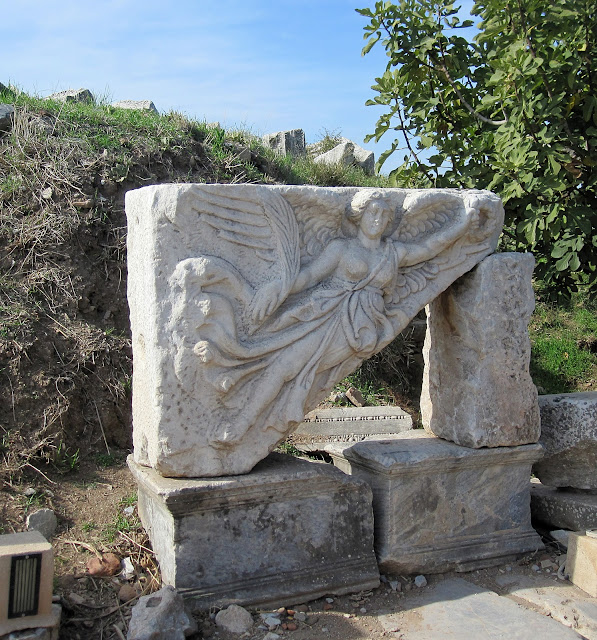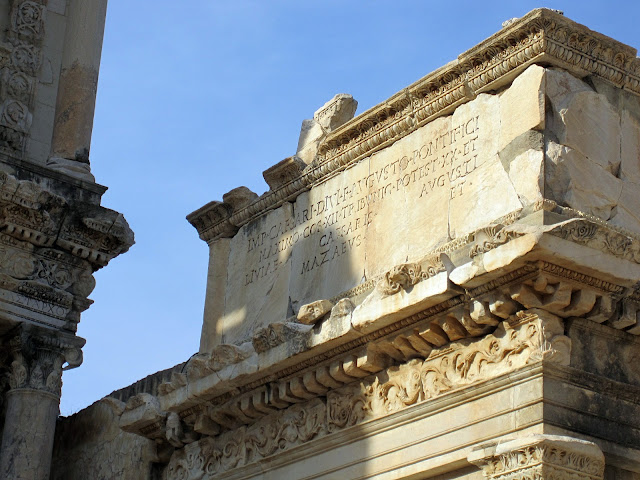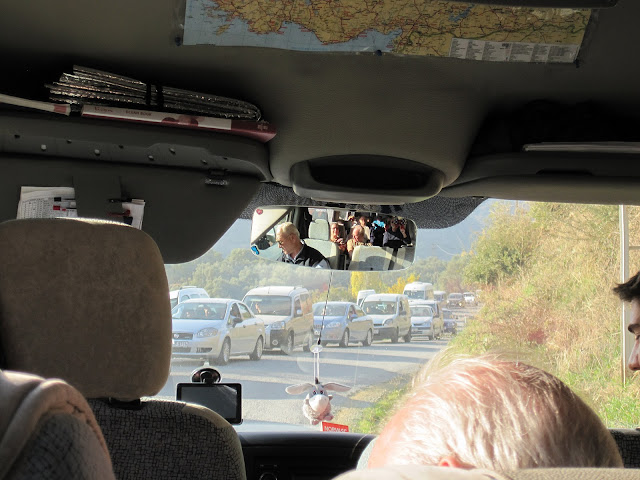Tours to Ephesus are a big business and there were lots of opportunities to get a taxi.
We were also going to be visiting the town of Selcuk and the Basilica of St. John.
Agriculture is a major industry in Turkey. The most important crops are cotton, olive oil, oranges, peaches, figs and strawberries. Sheep are the major livestock group.
Our first stop was to visit the house of the Virgin Mary. According to the bible the crucified Christ asked St. John to look after his mother, Mary. Mary came to Ephesus with John in 37 AD and settled in a modest stone house. This cistern was built by the Romans in 200 AD to capture the water from a spring near Mary’s house.
Our guide, Emre, was fantastic. He was 27 years old and had studied for four years in the capital of Ankara to become a tourist guide. His explanations were often lengthy, but excellent. No wonder Jim took so many notes.
Our on way to Mary’s house…
The discovery of Mary’s house came after a woman from Germany had a vision.
We passed by a statue of Mary.
The grounds on the way to the house were beautiful and very clean.
Pope Benedict XVI conducted a service from this pulpit in 2006. Emre felt very fortunate to be at that service and was situated within feet of the Pope.
Mary’s house was discovered in the early 20th century, but was left unrestored until the 1950s.
The dark line on the house shows the original foundation; the upper portion has been reconstructed.
Jim and Kim at Mary’s house…
You were encouraged to take candles and place them in the boxes as you said a prayer.
Jim looking pretty perky!
Water from the spring near Mary’s house is considered to be sacred. My bright idea was to empty my water bottle and fill it with sacred water. What was I thinking? With all this talk of sacred water, I was expecting it to taste so fresh and clean. The small sip I had tasted like brackish, stagnant water. Blech! My stomach told me what it was thinking the next day!
This crazy looking wall is pieces of napkins, papers, post-it notes and toilet paper with prayers written on them. When the wall is full, the Bishop takes them all down and burns them, releasing the prayers to heaven.
Our driver, Ali, was quite well known in the area as a wild boar hunter. All the other drivers would gather around and talk with him when we parked. We never did get a picture of him, but he was very smiley and accommodating. His very nice van had his name in the lower right corner.
Beautiful countryside…
An honest vendor!
And we arrived at the ruins. Ephesus became a significant port on the Aegean Sea in 1100 BC. However, silting of the harbour from the Menderes River resulted in the city being moved three times. The present site is the third move and was established by Alexander the Great in the 4th century BC. It was under the Romans from the 2nd century BC that the city really flourished. It became the major trading port where the Asian merchants on their camels met the European merchants with their ships. The excavation of Ephesus began in 1850 and is estimated to be about 30% complete today. During the period 200 BC to 400 AD, it was the wealthiest city in the world and was the second largest after Rome with 500,000 people. Mark Anthony and Cleopatra spent their honeymoon in Ephesus! This was the upper or Asian gate to the city.
The ruins in the background are the cistern. The floor of the cistern was made from thin marble slabs that were on pedestals. A fire was built under the floor to heat the water. Hot water was then piped through terracotta pipes to provide hot water for heating and bathing throughout the city. The world's first central heating!
These baths were established at each gate for the merchants to use after their long journeys.
Emre showing us a male fig tree. The milk from the leaves was used as an anti-aging cream. He pulled off a leaf and held it with the stem down and white liquid beaded out.
Terracotta pipes were used to transport hot and cold water throughout the city.
In an era where Christians were still being persecuted, this marked a meeting place. The faint upside down letters (I, X, O, Y, S) are Greek letters meaning Jesus Christ, God's son, Saviour. The fish was used by early Christians as a secret sign of Jesus.
This is the odeon or theatre. (Now we know where the Odeon Theatre gets its name.) It was part of the Roman state building where senators and councillors would meet.
More state offices…
Jim and Kim in front of the entry to the main Roman office building…
The smooth columns normally were used for temples, in this case, the Temple of Dormition.
The Dormition Square…
The sign for the hospital…
The ruins of the hospital…
A familiar sign indicating a pharmacy…
The pharmacy where papers with prescriptions were found. Many of these compounds found in the prescriptions are still in use today.
Nike, the Goddess of Victory…
The ever present cats…
Hercules Gates…leaving the Roman section and entering the citizen`s area.
The main street leading to the lower part of the city.
Along the main street were sets of stairs which would have led into the different shops.
The fountain building was donated by a wealthy Roman citizen to honour Artemis and Roman Emperor Trajan. Water spilled from the opening at the bottom between the columns to cool the hot pavement.
There were only 13 private houses in the city. This area in front of them was a meeting (coffee) place.
This well preserved mosaic floor shows intricate workmanship.
The uncovering of the Terrace Houses is an ongoing massive undertaking.
The original terrace houses (houses of the rich) as they appeared in 1967. These ruins of the first houses were uncovered in a haphazard fashion. Terrace houses 2 was just a mound on the right in 1967 waiting to be excavated.
Terrace Houses 1 and 2 in 2006. You can see the difference in how the second houses are being excavated.
As the rooms and halls were uncovered and reconstructed, pictures were drawn to depict their original state.
Marble was cut in very thin slabs using silk thread, which is virtually indestructible, and placed on the walls. The pattern in the marble suggests that this was all from the same slab.
This movie shows the extent of the seven dwellings under restoration.
The faces on these frescos were copied from masks used in the theatre.
The table in the Great Room of a house with a backgammon type of game etched on the top.
Individual rooms in the home were built around the Great Room. These rooms show the drawings on the walls.
A photo of a wall in the child`s bedroom shows that even then, children drew on the walls. Their heroes were gladiators as can be seen in the drawing.
The circular pedestals on the left were used in supporting the marble floor of the bath. The fireplace heated the slabs and the water used for bathing.
A well preserved mosaic of a lion on the floor. They were incredible artists!
More mosaics and frescoes. The wall paintings depicted everyday life in the Roman house including educational topics and social values.
Mosaic of Dionysus, the God of the Grape Harvest, on the left. These houses have the largest number of mosaic floors from the Roman Imperial period in western Turkey from 10 AD to 250 AD.
Many Turkish carpets today copy these early mosaic designs.
The entrance to the Temple of Hadrian, built to honour the visit of Emperor Hadrian in 123 AD.
The façade portrays mythical gods and goddesses.
The reliefs over the door depict the foundation of Ephesus.
The public latrines had water flowing through the trough underneath to remove the sewage. At the corner where the fresh water entered was an opening to dip a sponge for washing (or wiping).
They had people who would warm the seats in the cooler temperatures...
The main street with the Celsus Library in the background.
This magnificent building was a library built by Consul Galius Julius Aquila for his father in 114-117 AD. The library contained 12,000 books and was a meeting place for the scholars of the era. It had completely fallen down after an earthquake in 1000 AD.
The statues occupying the niches are Sophia (wisdom), Arete (valor), Ennoia (intellect) and Episteme (knowledge).
The gate to the commercial Agora which was the main marketplace of the city.
Great detail on the gate.
Looking down the street which ran in front of the marketplace and was paved with blocks of marble.
Looking down one side of the marketplace showing the traders stalls. The broken columns in the foreground once lined the marble street.
Marble street…
We are in front of the Theatre Gymnasium with the theatre in the background.
In the foreground are the remains of a huge gymnasium covering more than 12,000 square metres. The gymnasium contained exercise rooms, baths and an open courtyard for physical training. The theatre in the background can seat 25,000 people and is still in use. Elton John, Diana Ross, and Pavarotti have performed here, very different from the animal fights and gladiators in Roman times.
So many cats…
And with that, we left these fantastic ruins. You could spend so much time there. Lots of vendors outside with souvenirs and snacks for the tourists. Over 13 million people visited Ephesus last year.
And then we were off to Sirince for lunch.
Grapes vines…
Mandarin trees…
Because this was a major holiday in Turkey, many other people had the same idea of going to this quaint village for the day. After talking to some other guides who were in the town and couldn't get into any restaurants, Emre wisely made a decision to turn around.
When you drive a tractor, you can park on the sidewalk. (We made that rule up!)
We went instead to this restaurant in Selcuk for lunch.
It was about 3:30 by now and we were starved. They start each meal with bread and we devoured it! A Turkish meal followed with lamb sausages, braised lamb, pickles, yogurt, vegetables, olives…a feast!
And then we were off again to the Basilica of St. John built by Roman Emperor Justinian in the 6th century.
The Persecution Gate on the way to the church.
The Basilica was a massive structure measuring 130 m x 65 m. The fort in the background is a Byzantine citadel built in the 6th century.
The ruins today...
And a model showing the original Basilica...
The four columns were over the altar.
It was difficult to get an overall view of the church because of the size!
It is believed that St. John was buried here, but his bones were stolen by the Crusaders and taken to Italy.
The tomb of St. John which is continuously covered in dust. Popes have collected and preserved the dust believing it is from St. John’s remains. There are many myths associated with the tomb of St. John, one being that the dust from the tomb has healing powers.
This is the baptismal font at the entry to the church. Citizens had to be baptized before they could enter and here they could walk down one set of steps, be baptized in the centre and walk up the other set of steps into the church. Very efficient!
The Isa Bey Mosque with its preserved gardens was built in the 14th century. It is the oldest mosque in western Turkey.
View of the ruins with the almost full moon…it had been a long, but very amazing day.
Our next quick stop was at the last remaining column of the Temple of Artemis, one of the Seven Wonders of the Ancient World. The oldest artifacts found at this site date from the 14th century BC. Since the beginning of the Iron Age (11 BC) the site has been a place of worship. It was rebuilt three times before its eventual destruction in 401.
It had 127 columns about 60 feet tall. A model showing the original temple...
And what little remains today...
And after a quickie stop at a leather outlet (Turkish leather is beautiful), the sun set on an amazing day. Our minds were full!
Tomorrow we visit Athens...





































































































1 comment:
Sir, I am Supriya Ghosh Dastidar from Kolkata (India. I started to read your blog from October 2011. Now I am a fan of your Blog. Its really too good to see many places on earth.
Post a Comment